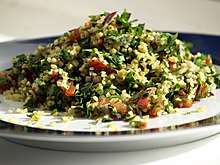Tabbouleh
Tabbouleh (Arabic: تبولة tabūla; also tabouleh, tabbouli, tabouli, or taboulah) is a Levantine vegetarian salad made mostly of finely chopped parsley, with tomatoes, mint, onion, bulgur (soaked, not cooked), and seasoned with olive oil, lemon juice, salt and sweet pepper. Some variations add lettuce, or use semolina instead of bulgur.[1][2]
 Tabbouleh | |
| Course | Salad |
|---|---|
| Place of origin | Lebanon and Syria |
| Region or state | Levant, Middle East |
| Serving temperature | Cold |
| Main ingredients | Parsley, tomato, bulgur, onion, olive oil, lemon juice, salt |
| Variations | Pomegranate seeds instead of tomato |
Tabbouleh is traditionally served as part of a mezze in the Arab world. Its popularity has grown in Western cultures.[3]
Etymology
The Levantine Arabic tabbūle is derived from the Arabic word tābil, meaning "seasoning"[4] or more literally "dip". Use of the word in English first appeared in the 1950s.[4]
History
Edible herbs known as qaḍb[5] formed an essential part of the Arab diet in the Middle Ages. Dishes like tabbouleh attest to their continued popularity in Middle Eastern cuisine today.[6] Originally from the mountains of Lebanon and Syria,[7] tabbouleh has become one of the most popular salads in the Middle East.[8] The wheat variety salamouni cultivated in the Beqaa Valley region in Lebanon, was considered (in the mid-19th century) as particularly well-suited for making bulgur, a basic ingredient of tabbouleh.[9] In Lebanon, the Lebanese National Tabbouleh Day is a yearly festivity day dedicated to Tabbouleh. Since 2001, it is celebrated the first Saturday of the month of July.[10]
Regional variations
In the Middle East, particularly Syria, Lebanon, Palestine, Jordan, Egypt, and Iraq, it is usually served as part of a meze. The Syrian and the Lebanese use more parsley than bulgur wheat in their dish.[11] A Turkish variation of the dish known as kısır,[8] and a similar Armenian dish known as eetch use far more bulgur than parsley. Another ancient variant is called terchots. In Cyprus, where the dish was introduced by the Lebanese, it is known as tambouli. In the Dominican Republic, a local version introduced by Syrian and Lebanese immigrants is called Tipile.[12]It is also popular in Israel on regular and holiday occasions[13]
Like Hummus, Baba Ghanoush, Pita bread, and other elements of Arab cuisine, tabbouleh has become a popular food in America.[3]
References
- Sami Zubaida, "National, Communal and Global Dimensions in Middle Eastern Food Cultures" in Sami Zubaida and Richard Tapper, A Taste of Thyme: Culinary Cultures of the Middle East, London and New York, 1994 and 2000, ISBN 1-86064-603-4, p. 35, 37; Claudia Roden, A Book of Middle Eastern Food, p. 86; Anissa Helou, Oxford Companion to Food, s.v. Lebanon; Maan Z. Madina, Arabic-English Dictionary of the Modern Literary Language, 1973, s.v. تبل
- Oxford Companion to Food, s.v. tabbouleh
- Zelinsky, 2001 p. 118.
- Mark Morton (2004). Cupboard Love: A Dictionary of Culinary Curiosities (2nd ed.). Insomniac Press. p. 302. ISBN 978-1-894663-66-3.
tabbouleh dictionary meaning.
- "Tabouli Parsley and Bulgur Salad". Arousing Appetites. Arousing Appetites.
- Wright, 2001, p. xxi.
- Madison Books, ed. (2007). 1,001 Foods to Die For. Andrews McMeel Publishing. p. 172. ISBN 978-0-7407-7043-2.
- Basan, 2007, p. 180-181.
- Nabhan, 2008, pp. 77-78.
- A Complete Insiders Guide to Lebanon. Edition Souk el Tayeb Press. December 2008, pp 266-267.
- Wright, 2001, p. 251. "In the Arab world, tabbouleh (tabbūla) is a salad usually made as part of the mazza table (p xx) especially in Syria, Lebanon and Israel."
- Brown, Isabel Zakrzewski (1999). Culture and Customs of the Dominican Republic. Greenwood Publishing Group. p. 56. ISBN 9780313303142.
- Degutiene, Nida (2015-08-18). A Taste of Israel – From classic Litvak to modern Israeli. Penguin Random House South Africa. ISBN 978-1-4323-0654-0.
Bibliography
- Basan, Ghillie (2007). The Middle Eastern Kitchen. Hippocrene Books. ISBN 978-0-7818-1190-3.
- Caplan, Patricia (1997). Food, health, and identity (Illustrated ed.). Routledge. ISBN 978-0-415-15680-6.
- Nabhan, Gary Paul (2008). Where our food comes from: retracing Nikolay Vavilov's quest to end famine (Illustrated ed.). Island Press. ISBN 978-1-59726-399-3.
- Positive Lebanon (Tamyras ed.). 2014. ISBN 2360860666.
- Wright, Clifford A. (2001). Mediterranean vegetables: a cook's ABC of vegetables and their preparation in Spain, France, Italy, Greece, Turkey, the Middle East, and north Africa with more than 200 authentic recipes for the home cook (Illustrated ed.). Harvard Common Press. ISBN 978-1-55832-196-0.
- Zelinsky, Wilbur (2001). The enigma of ethnicity: another American dilemma (Illustrated ed.). University of Iowa Press. ISBN 978-0-87745-750-3.
| Wikibooks Cookbook has a recipe/module on |
| Wikimedia Commons has media related to Tabbouleh. |